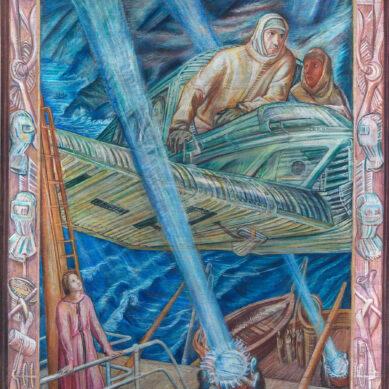You searched
Painter
Ferruccio Ferrazzi
Are you interested in the sales or the purchase of his artworks?
We buy works of this artist
and of other painters and sculptors from the 16th century to the first half of the 20th century
The Berardi gallery offers a free and without obligation service for evaluation of ancient and modern art . To find your way in the art market, very complex and full of nuances, it is better to rely on a professional consultant who can answer fast and concretely to your needs. The clarity of the answers will resolve effectively the need to estimate or sell an asset.
Contact us immediately without commitment
Answers also in 24 hours:
Ferruccio Ferrazzi
Ferruccio Ferrazzi
Ferruccio Ferrazzi acquires the first rudiments of drawing from his artist father, but later enrolled at the Academy of San Luca, where he attended the lessons of Umberto Coromaldi and Giulio Aristide Sartorio. He made his debut at the age of sixteen with a self-portrait exhibited in 1907, while in 1908 he exhibited Calce in Rome.
1910 is the year in which, very precociously, he participates in his first Venice Biennale, exhibiting Self-portrait and Manca il lavoro. The hearth appears at the International Exhibition of Rome in 1911, a painting that obtained immediate critical success, so much so that it was purchased by the National Gallery.
Three years later he went to Paris following his father: during his stay he came into contact with the post Impressionism and with the art of Cézanne which had a strong influence on him. In this period, his paintings are interwoven with symbolist elements inherited from the master Sartorio, but also with chromatic and compositional cues from Expressionism. Ferrazzi’s language soon turned towards a personal expressionism, of a symbolic nature, as demonstrated by La genitrice, exhibited at the exhibition of the Roman Secession in 1913.
The Society of Amateurs and Connoisseurs of Fine Arts of Rome, in 1916 dedicates a solo exhibition to him that Ferrazzi sets up with great originality: the prism-shaped room is the setting for particular canvases and futurist, dynamic and strongly symbolic perspectives. These are the years in which he is halfway between the Futurist and the Expressionist addresses.
It is also true that in 1919 he took part in the National Exhibition of Futurism at Palazzo Cova in Milan, but they are the last offshoots of a language linked to Futurism, in fact since the 1920s his poetics has refined and promoted a completely personal style .
As happens for many artists, in the post-war period a return to order occurs in Ferrazzi: the torment and drama of Nordic expressionism, with its almost hallucinatory meaning, is combined with a stillness and balance of an ancient matrix. Giottesco’s fourteenth century can be read in the almost hieratic figures of the women he represents absorbed in their thoughts.
In 1922 he married his muse, Horitia Randone, the subject of many of his paintings. In 1923 he participated in the Roman Biennale with The characters of my family, while in 1926 he obtained the Carnegie prize of Pittsburgh with Prismatic Vision and in 1927 with Horitia and Fabiola. From this moment on he became one of the most appreciated authors of the American review, in which he will participate for many more years.
Idol of the prism was exhibited at the 1925 Exhibition of Italian Art in America, the year in which Ferrazzi began to frequent Acqui Terme, in particular the home of the Ottolenghi family. This commissioned the mural decoration of their Tempietto, a work that Ferrazzi begins with fresco and encaustic, techniques that will later become his characteristic figures over the years.
With mural painting the true classicist soul of the artist is revealed: the imposing Masaccesque bodies are inserted in fifteenth-century architecture; these elements that blend harmoniously with characteristics inherited from the Mexican muralist Diego Rivera, but also from the static nature of Mario Sironi. Galileo and Aurora rising from the sea are instead the wall decorations that Ferruccio Ferrazzi created for the science room of the University of Padua and again, in the Palazzo di Giustizia in Milan, he encausticed the Clemenza di Traiano and Daniele in the lions’ den.
The reference to a classic and statuary past is present in each of these imposing and majestic cycles, with all the wisdom of an ancient master. All this is combined with a visionary and imaginative character unmatched in Italy, which is also reflected in his non-mural works.
At the personal exhibition at the 1931 Roman Quadrennial, he presents many works including oils, drawings, frescoes and encaustics such as The Angel and the Spirit, My Sister Adele, Pietà, Aniene in Tivoli, Donne di notte, I Mammellari, Horitia, Mrs. Ottolenghi . Two years earlier, he had obtained the chair of mural decoration at the Academy of Fine Arts in Rome, teaching the generation of artists who later joined the Roman School. He continued to paint tirelessly throughout the 1940s and 1950s, then moved in the last few years to his home in the Argentario. He died in Rome in 1978.
Elena Lago












